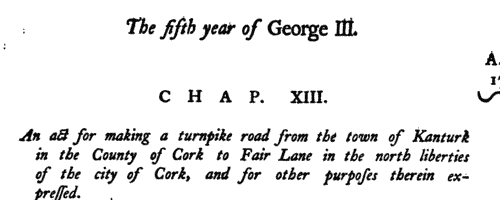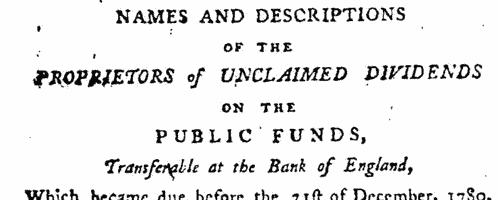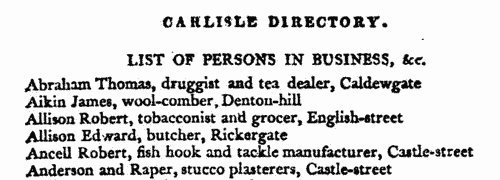Harmond Surname Ancestry ResultsOur indexes 1000-1999 include entries for the spelling 'harmond'. In the period you have requested, we have the following 15 records (displaying 1 to 10): Buy all | | | Get all 15 records to view, to save and print for £94.00 |
These sample scans are from the original record. You will get scans of the full pages or articles where the surname you searched for has been found. Your web browser may prevent the sample windows from opening; in this case please change your browser settings to allow pop-up windows from this site. London Liverymen: Wax Chandlers
(1537)
J. Caley, F.R.S., F.S.A. transcribed this 'curious record' found in the Chapter House, Westminster, 'a list of the freemen of the various companies resident in London and Westminster; from Thomas Lewyn being mentioned as sheriff, it appears it was made in the year 1537.' Thirty-seven companies are listed, comprising 2400 individuals: Armourers, Bakers, Barber Surgeons, Blacksmiths, Brewers, Broiderers, Clothworkers, Coopers, Cordwainers, Curriers, Cutlers, Drapers, Fishmongers, Fletchers, Founders, Freemasons, Fruiterers, Goldsmiths, Grocers, Haberdashers, Innholders, Ironmongers, Joiners, Leather Sellers, Merchant Taylors, Painter Stainers, Plasterers, Plumbers, Saddlers, Salters, Skinners, Spurriers, Tallow Chandlers, Tilers, Vintners, Wax Chandlers and Weavers. HARMOND. Cost: £6.00.  | Sample scan, click to enlarge

| Allegations for marriages in southern England
(1660-1669)
The province or archbishopric of Canterbury covered all England and Wales except for the northern counties in the four dioceses of the archbishopric of York (York, Durham, Chester and Carlisle). Marriage licences were generally issued by the local dioceses, but above them was the jurisdiction of the archbishop, exercised through his vicar-general. Where the prospective bride and groom were from different dioceses it would be expected that they obtain a licence from the archbishop; in practice, the archbishop residing at Lambeth, and the actual offices of the province being in London, which was itself split into myriad ecclesiastical jurisdictions, and spilled into adjoining dioceses, this facility was particularly resorted to by couples from London and the home counties, although there are quite a few entries referring to parties from further afield. The abstracts of the allegations given here usually state name, address (street in London, or parish), age, and condition of bride and groom; and sometimes the name, address and occupation of the friend or relative filing the allegation. Where parental consent was necessary, a mother's or father's name may be given. The ages shown should be treated with caution; ages above 21 tended to be reduced, doubtless for cosmetic reasons; ages under 21 tended to be increased, particularly to avoid requiring parental consent; a simple statement 'aged 21' may merely mean 'of full age' and indicate any age from 21 upwards. These are merely allegations to obtain licences; although nearly all will have resulted in the issuing of the licence, many licences did not then result in marriage. HARMOND. Cost: £4.00.  | Sample scan, click to enlarge

|  Apprentices registered at Chichester in Sussex
(1712-1713) Apprentices registered at Chichester in Sussex
(1712-1713)
Apprenticeship indentures and clerks' articles were subject to a 6d or 12d per pound stamp duty: the registers of the payments usually give the master's trade, address, and occupation, and the apprentice's father's name and address, as well as details of the date and length of the apprenticeship. There are central registers for collections of the stamp duty in London, as well as returns from collectors in the provinces. These collectors generally received duty just from their own county, but sometimes from further afield. January 1712 to June 1713. (The sample entry shown on this scan is taken from a Norfolk return)HARMOND. Cost: £8.00.  | Sample scan, click to enlarge

| Licences for marriages in southern England
(1632-1714)
The province or archbishopric of Canterbury covered all England and Wales except for the northern counties in the four dioceses of the archbishopric of York (York, Durham, Chester and Carlisle). Marriage licences were generally issued by the local dioceses, but above them was the jurisdiction of the archbishop. Where the prospective bride and groom were from different dioceses it would be expected that they obtain a licence from the archbishop; in practice, the archbishop residing at Lambeth, and the actual offices of the province being in London, which was itself split into myriad ecclesiastical jurisdictions, and spilled into adjoining dioceses, this facility was particularly resorted to by couples from London and the home counties, although there are quite a few entries referring to parties from further afield. Three calendars of licences issued by the Faculty Office of the archbishop were edited by George A Cokayne (Clarenceux King of Arms) and Edward Alexander Fry and printed as part of the Index Library by the British Record Society Ltd in 1905. The first calendar is from 14 October 1632 to 31 October 1695 (pp. 1 to 132); the second calendar (awkwardly called Calendar No. 1) runs from November 1695 to December 1706 (132-225); the third (Calendar No. 2) from January 1707 to December 1721, but was transcribed only to the death of queen Anne, 1 August 1714. The calendars give only the dates and the full names of both parties. Where the corresponding marriage allegations had been printed in abstract by colonel Joseph Lemuel Chester in volume xxiv of the Harleian Society (1886), an asterisk is put by the entry in this publication. The licences indicated an intention to marry, but not all licences resulted in a wedding. HARMOND. Cost: £4.00.  | Sample scan, click to enlarge

|  Apprentices registered at Colchester in Essex
(1758) Apprentices registered at Colchester in Essex
(1758)
Apprenticeship indentures and clerks' articles were subject to a 6d or 12d per pound stamp duty: the registers of the payments usually give the master's trade, address, and occupation, and the apprentice's name, as well as details of the date and length of the apprenticeship. There are central registers for collections of the stamp duty in London, as well as returns from collectors in the provinces. These collectors generally received duty just from their own county, but sometimes from further afield. The indentures themselves can date from a year or two earlier than this return. (The sample entry shown on this scan is taken from a Bristol return. Each entry has two scans, the other being the facing page with the details of the indenture, length of service, and payment of duty.) IR 1/53HARMOND. Cost: £8.00.  | Sample scan, click to enlarge

| Kanturk to Fair Lane Turnpike Trustees
(1765)
The act for making a turnpike road from the town of Kanturk in the county of Cork to Fair Lane in the north liberties of the city of Cork (5 George III cap. xiii) appointed a large number of local gentlemen to serve as initial trustees.HARMOND. Cost: £6.00.  | Sample scan, click to enlarge

| Unclaimed Dividends: Consolidated 3 Per Cent Annuities
(1791)
In Spring 1791 this list was issued, of the 'Names and Descriptions of the Proprietors of Unclaimed Dividends on the Public Funds Transferable at the Bank of England, Which became due before the 31st of December, 1780, and remained unpaid the 31st of December, 1790. With the Dates when the first Dividends respectively became payable, and the number of Dividends due thereon.' HARMOND. Cost: £6.00.  | Sample scan, click to enlarge

| Hospital governors, staff and officials
(1805)
Governors, surgeons, officers and clerks of several hospitals, both official and charitable, are listed in Holden's Triennial Directory of 1805 to 1807: St Bartholomew's in West Smithfield; Christ's, in Newgate Street; Bridewell and Bethlehem on New Bridge Street; St Thomas's, in Southwark; the Royal Hospital in Chelsea; the London Hospital in Whitechapel Road; Guy's, in Southwark; St George's, on Hyde Park Corner; St Luke's, for lunatics, in Old Street; and the Royal Hospital in Greenwich.HARMOND. Cost: £8.00.  | Sample scan, click to enlarge

| Navy Officials and Clerks
(1805)
Officials of the Admiralty Office at Charing Cross, the Marine Department, the Navy Office at Somerset House, Secretary's Office, Contract Office, Office for Bills of Account, Office for Seamen's Wages, Allotment Office, Surveyor's Office, Office for Examining the Treasurer's Accounts, Ticket Office, Office for Examining Storekeepers' Accounts, Office for Stores and Slops, Deptford, Woolwich, Chatham and Sheerness dockyards, the Navy Pay Office, the Victualling Office in Somerset Place, the High Court of Admiralty at Doctors Commons, and the bona fide Navy Agents, are listed in different sections of Holden's Triennial Directory of 1805 to 1807, and are indexed here.HARMOND. Cost: £8.00.  | Sample scan, click to enlarge

| Inhabitants of Workington
(1811)
F. Jollie and Sons of Carlisle printed this Cumberland Guide and Directory 'containing a Descriptive Tour through the County, and a List of Persons in Public and Private Situations in every Principal Place in the County'. The sample scan is from the Carlisle directory: this is the index to the section for Carlisle.HARMOND. Cost: £6.00.  | Sample scan, click to enlarge

|
| 1 | 2 |  |
Research your ancestry, family history, genealogy and one-name study by direct access to original records and archives indexed by surname.
|













